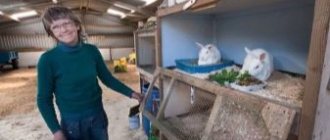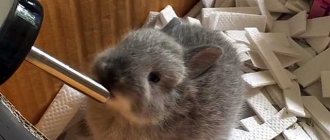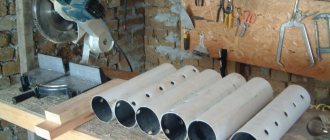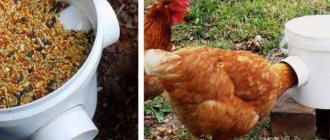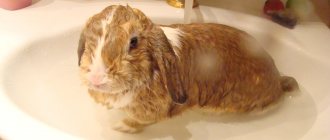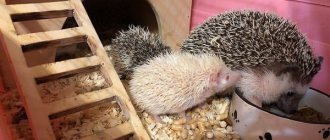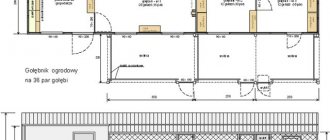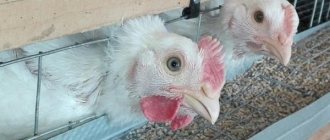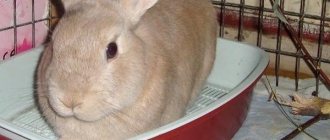What should the enclosure be like?
Aviary keeping of rabbits
An aviary for rabbits has the following characteristics:
- Typically, to keep up to 30 rabbits, it is necessary to fence off 20 square meters of open space, located on a small hill, so that moisture does not accumulate.
- The fence can be either wooden or made of mesh materials.
- The ceiling height should be at least one and a half meters, as rabbits can jump very high.
- The walls should be dug deeper into the ground to avoid undermining and escape of the wards.
- The floor of the enclosure remains earthen , this is more familiar to animals; they will be able to dig holes, as in the wild, and also feast on fresh growing grass. If it is impossible to leave the floor earthen, it must be carefully insulated with hay or sawdust in sufficient quantities so that animals can burrow there in case of cold weather.
- Some part of the enclosure should have a roof to provide shelter from precipitation; you can also build houses where rabbits can shelter in bad weather and bring offspring. For ease of cleaning, the roof of such a home is made to open.
“The enclosure should not have any nooks and crannies where it would be difficult for a person to get into. Rabbits can climb somewhere, they can even die there. Therefore, it is necessary that all places are visible and accessible, so that you can easily get into them” (rabbit breeder I. Stepanov).
Construction of houses
In order to spend the night, spend the winter and breed offspring in an enclosure, rabbits will need nests. A rabbit nest is a small house with an entrance door and internal partitions for females and babies.
The houses in the enclosure are built on a hill so that the inside is dry and warm. Therefore, you first need to drive the supports into the ground, then attach the lower frame to them and build a wooden frame. Subsequently, the internal walls of the rabbit house are covered with boards or plywood, a layer of insulation is laid, then the insulation is also covered with plywood or slab.
The roof of the house should be slightly sloping so that rabbits can sit or lie on it
The roof is also insulated, insulated with film or roofing felt (especially important if the enclosure does not have a canopy), then sheathed with corrugated sheets or other material
Pros and cons of content
Pros:
- Conditions closer to natural have a positive effect on the appetite and mood of rabbits;
- reproduce willingly under these conditions;
- When kept in enclosures, animals almost never get sick;
- It's economical. Less building materials are needed for the construction than for individual cells. And building an enclosure is simple and takes little time; it can be done in half a day;
- Space is saved. Many animals can live in one enclosure. If you make a personal cage for each of them, then you will need many times more square meters;
- feed and water all the animals at one time by pouring them into a common feeder and pouring water into one large drinking bowl. Also, when kept in an enclosure in the summer, rabbits can eat grass that grows in the enclosure;
- Easy to care for: the enclosure needs to be cleaned less often than cages. It is possible to make such an enclosure at your summer cottage, caring for rabbits only on weekends;
- If you use sawdust for bedding , you get good fertilizer;
- Protection from attacks by rats or other predatory animals. The rabbit family in a crowd will be able to fight back and protect their offspring.
Minuses:
- Seasonality of such content. For the winter, all the livestock will either have to be slaughtered or moved to a warmer room;
- Vulnerability to infections. If one of the herd gets sick, all the rabbits are more likely to die;
- This type of housing is not suitable for rabbits of large meat breeds, because... implies physical activity. Rabbits kept in cramped cages are fattier and have more tender meat due to underdeveloped muscles;
- Different female rabbits can give birth in one place, and later rabbits may die;
- A rabbit accustomed to an enclosure can also
How is a corral useful?
Raising rabbits in pens allows them to gain weight quickly while remaining healthy. In addition, movement allows them to cope better with illnesses.
How to distinguish Astrakhan watermelon from Uzbek one. Astrakhan watermelon: description, properties, growing methods || Astrakhan watermelon - how is the old variety so different from many new ones?!
In pens, rabbits are easier to care for, clean, and feed with twig food. If there are several females with small rabbits in one pen, they all take care of them together, which has a good effect on the health of the babies.
And the last thing is ease of creation. If you have space at your dacha and don’t have time to make a cage yet, this option for keeping rabbits is ideal. It does not require a lot of money and is created in a few hours.
How to build it yourself?
Construction requirements
Before you start building an enclosure for rabbits, you need to choose a suitable place where it will be located.
The main requirement for placement is that the enclosure is installed in an elevated place to avoid flooding during rainy periods and melting snow.
In the southern regions, farmers recommend installing an enclosure in the light shade of trees to protect their pets from overheating. In the northern regions, they do things differently - housing for rabbits is placed in the open sun.
How to calculate area?
Having decided on the location, you need to correctly calculate the area of the structure. It is determined based on the number of livestock. On average, each rabbit should have at least 0.7 m2.
Rabbits with baby rabbits will need more space. The optimal value is 1 m2 for each adult.
Construction Materials
To build an enclosure with your own hands you will need building materials:
- bars;
- board;
- metal mesh;
- supports (you can use pipes or metal pegs);
- shovel;
- screws, nails;
- screwdriver;
- door hinges;
- lock;
- slate;
- sand;
- sawdust.
Attention! It is important to correctly calculate the perimeter of the enclosure in order to purchase the required amount of mesh, boards and slate. It should be taken into account that the side parts of the enclosure are dug to a depth of at least 0.8 m so that the rabbits cannot dig under the ground and escape.
Construction phase
Enclosure plan
Having chosen a suitable place on the site to build an enclosure for rabbits, you need to take measurements and draw markings.
At the initial stage, a ditch is dug into which the walls of the slate structure will be deepened.
Supports are dug into the corners to a depth of 0.8 m.
Sheets of slate are placed in the recesses (it is more convenient to use flat slate). They are fastened together. The ditch is filled with earth and compacted, and the site is leveled.
The mesh is attached to the metal corner supports using self-tapping screws.
The height of the walls of the structure is 1 m. It is advisable to cover the back of the structure with a board to protect the animals from drafts. A door is installed on the front or one of the side walls.
The top layer of soil inside the enclosure to a depth of 15 cm must be removed, and sand should be poured in its place.
A mesh is fixed over the sand layer, onto which sawdust is then poured. Some farmers leave the dirt floor, others concrete it and then insulate it with bedding.
Attention! Not all breeds are able to live on a mesh floor. Heavier rabbits and those with sparsely furred feet will suffer from pododermatitis.
Mandatory attributes of the enclosure are shelters - houses made of wood, where pets will hide when they are cold or scared, and rabbits with litter also need such shelters. It is in them that the birth occurs.
If desired, you can build a small canopy over the structure; it will protect the rabbits from the hot sun, rain and snow.
Drinkers and feeders are installed inside the enclosure. It is important to ensure that this equipment meets the needs of the entire livestock, otherwise the rabbits will fight for food and water.
You can move eared animals into your finished home.
Arrangement of the floor in the enclosure
To properly arrange the floor in the enclosure, you need to follow the following recommendations:
- It is advisable to lay a fine mesh net on the floor to make cleaning easier.
- It is necessary to lay thin bars on the mesh, leaving small gaps between them.
- The boards must be laid at an angle of 45º relative to the transverse beams of the fence, otherwise the rabbits may injure themselves. In addition, do not forget that animals will definitely gnaw the tree.
- Before you start building an enclosure, it is generally necessary to prepare a detailed drawing in which the room is divided into living areas, food compartments and drinking bowls. This will make the construction process much easier.
- In specialized stores, you can purchase special plastic ladders for rabbits as a covering, which are laid instead of bars. This will make it much more comfortable for the animals. In addition, cleaning them is much easier, and the process of rotting is not terrible for the material, unlike wood.
Construction of an enclosure-pit
Photo of the pit:
In order to build such an enclosure, it is necessary to fence the enclosure area with a net. Slate is dug along the perimeter of the enclosure along the mesh so that the rabbits do not dig passages out.
Sheets with a height of 40-50 cm are used, since animals do not dig holes of greater depth.
Inside the enclosure you need to place feeders with grain and hay, as well as nipple drinkers.
Sparrows or other birds may flock to feed, which will increase the risk of animals becoming infected with viral diseases.
To avoid this, cover the top of the enclosure with a net. This will also keep rabbits safe from dogs and cats.
This simple design is suitable for summer keeping rabbits . Females can be placed in the enclosure. Males are placed in a separate area to control the breeding of rabbits.
There will be fights among males in the first days of cohabitation. When the territory is divided and a hierarchy is established, conflicts will stop.
Rabbit enclosures covered with chain-link mesh allow too much light to enter, making the animals feel uncomfortable.
Therefore, it is necessary to install wooden booths with a dirt floor or canopies in the enclosure, which will provide shade inside the open space. It is in shaded areas that rabbits will dig holes.
A fenced-in rabbit run area has its advantages and disadvantages.
The advantages include the following features:
- It is easy to care for animals in such an enclosure and monitor their health;
- the fenced enclosure is well suited for mating animals;
- it is easy to clean in the open walking area, since the floor remains earthen;
- In the enclosure, the conditions for keeping rabbits are close to natural, the animals develop strong immunity, so they get sick less.
The disadvantages of the walking area include:
- lack of queen cell;
- increased consumption of feed for fattening animals;
- slow weight gain in rabbits.
Unlike cage housing, it is difficult to arrange a queen cell for baby rabbits in a fenced walking area.
Without a separate queen cell, adults can kill the offspring, which makes it difficult to breed rabbits in an enclosure.
Using only hay and grain to feed rabbits, you will not be able to get good weight gain.
Giant rabbits, for example the Gray Giant breed, need to be fattened for meat for at least 6 months, using expensive feed.
Otherwise, rabbits will not gain weight. Therefore, keeping rabbits in an enclosure with a fenced walking area is unprofitable.
This enclosure is more suitable for keeping downy breeds of rabbit.
This is what a house for a two-tier rabbit enclosure might look like. Schematic representation of an enclosure for keeping rabbits in winter.
Results
Photos of ready-made rabbit enclosures will definitely help a novice farmer decide on the design of a rabbitry. It won’t be difficult to bring the idea to life, because an open enclosure is one of the simplest structures. But rabbits in a spacious enclosure feel much more comfortable than in a cramped cage.
The construction of a rabbit enclosure is described in detail in the video:
- DIY greenhouse from old window frames
- Making a garden bench with your own hands
- Dimensions of a booth for a shepherd, alabai and other dogs
- How to make a homemade smokehouse with your own hands
Aviary care
Timely hygiene is the prevention of most diseases in rabbits.
It is necessary to clean the enclosure weekly, removing waste and treating it with special veterinary agents that prevent the growth of bacteria.
Make sure that the hay and sawdust in the enclosure are always fresh and do not allow them to rot.
Change the water in the drinking bowls regularly, making sure that it is always in the required quantity.
Feeders and drinkers for rabbits
Types of feeders for rabbits:
Bowls Hopper Chute Nursery
- Bowls. You can take regular dishes, but active rabbits can easily turn them over.
- Bunkers. This design of the feeder prevents food from being scattered throughout the enclosure; food is poured there once every couple of days.
- Gutter This feeder is easy to make and several rabbits can feed from it.
- Nurseries. Used for hay.
Types of drinking bowls for rabbits:
Bowl Cup Vacuum Nipple Automatic
- Bowls. You can take regular dishes, but, just like with feeders, rabbits can turn them over, which can lead to dampness and mold in the enclosure. And the rabbits themselves will be thirsty.
- Cupped. They are made from bottles and have a fairly large volume.
- Vacuum. Can also be made from plastic bottles. The water in such drinking bowls stays fresh longer.
- Nipple. Special drinking bowls with a ball at the end. The rabbit drinks by pressing the ball with its tongue. The most versatile type of drinking bowls for rodents. Water does not flow out of such a container on its own, does not evaporate, and the rabbit cannot turn it over. Disadvantages can only occur in winter, when the ball freezes.
- Automatic. Drinkers for large farms. From a large container, water is automatically supplied through tubes into the enclosure.
Main characteristics
To arrange the enclosure, it is necessary to select a sufficiently large area. It is advisable to choose areas that are as flat as possible, without slopes or any hills or lowlands. In general, a rabbit enclosure is an open area located directly on the ground and fenced on each side with chain-link mesh.
Note! An important element of the enclosure design is the canopy, which will protect the animals from direct sunlight and the invasion of uninvited guests.
Design parameters for breeding animals depend on their number. For example, an area of 25 m2 will allow you to raise from 25 to 30 rabbits at the same time.
The most suitable place for organizing a pen for rabbits in the country is the area adjacent to the barn. One of the walls will serve as the end wall of the barn. It is near it that houses for rabbits should be located.
Breeding rabbits in an aviary
If you are going to breed rabbits in an enclosure, then you should adhere to the following recommendations:
- When the enclosure is ready , it is necessary to populate it correctly. All the rabbits are released there at once, subsequently they will be replenished with rabbits born there;
- But it’s better not to add strangers to an already formed family - they won’t accept you;
- with the exception of females, which are kept separately from males, joining them only for the purpose of reproduction. Males are not placed with females;
- a day after mating, a “control” mating is carried out so that the rabbit definitely becomes pregnant; when the goal is achieved, the males again settle separately. Female rabbits raise their offspring for up to three to four months, after which new males emerge from the offspring and also breed;
- female rabbits kept together are friendly to both their own and other people’s offspring, if it smells “familiar”, the females can feed all the rabbits of the herd;
- male rabbits need to be separated and in order to prevent a double pregnancy of the female rabbit, their body is designed in such a way that this is possible, but such offspring will be smaller and less viable;
- for breeding, female rabbits need queen cells - artificial burrows, which can be replaced with boxes or special houses with an opening roof;
- Mating between blood-related rabbits (father-mother-son-daughter-brother-sister) should not be allowed; the offspring may be unhealthy;
- if you breed rabbits for sale , cross only one breed of the same color; animals of different colors are not considered purebred.
Do not place an enclosure with rabbits next to poultry. They can become infected with a common infection and die all at once.
Readiness for reproduction:
- Large breeds – 8 months female, 9 months male.
- Medium breeds – 6 months female, 7 months male.
- Small breeds – 5 months female, 6 months male.
The gestation period lasts about a month. A female rabbit can give birth to healthy young rabbits up to three or four years of age.
Breed selection
There are different types of rabbits for breeding: meat; meat skins; sandpaper; downy; decorative.
In total, experts count about 200 individual breeds that are well suited for breeding.
General rules
In order for rabbits to grow healthy and reproduce well, you need to adhere to the following rules for caring for them:
- The key to an animal's health and good mood is air, movement, sun and good food.
- To satisfy the need for food and water, feeders and drinking bowls are placed in the enclosures in the quantities needed for the entire family to prevent fights.
- Drinking bowls should be placed in different corners of the enclosure so that animals do not crowd around them, but can drink freely.
- The basis of the diet in summer is fresh grass, and in winter – hay.
- To sharpen their teeth, rabbits need tree branches, for example, pine, willow, aspen, poplar, apple, linden, maple, birch, spruce, juniper.
- Cramped enclosures are vulnerable to widespread animal disease. Once one person gets sick, everyone can die.
- To prevent infections, it is better to vaccinate the entire population of rabbits.
- Use special products to disinfect the enclosure, feeders and drinking bowls.
- During pregnancy, the rabbit needs special care and increased nutrition, rich in vitamins and minerals.
